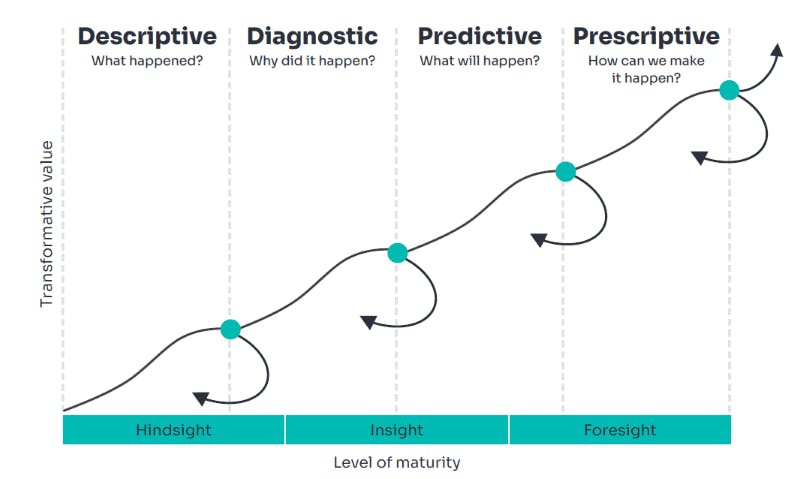

Making smart choices on new technology can drive organizational success
For years, companies have looked to various digital technologies to help them better serve their customers and improve operational efficiencies. The challenges and resources associated with outdated processes and systems give organizations a compelling business case to invest in technology.
For CFOs, digital transformation is a top priority, but only if a new technology drives revenue and improves process inefficiencies. CFOs are looking for IT transformations that allow work to be done bigger, better, faster and cheaper.
Data maturity journey
Organizations are increasingly looking at their data as a core asset to what they do. The data maturity journey reflects an organization’s ability to work with its data differently over time.
At the early stage of data maturity, organizations tend to do more manual manipulation of key data, which usually provides a backward look at the business. The data provide a picture about what happened but tell the organization very little about where it is going.
Data maturity in an organization is moving from hindsight to foresight, where data provides insight into things like the sales pipeline, product development and correct staffing levels. At the far side of the data maturity model, amplified intelligence and automation mean organizations are managing their data so well that they need minimal human intervention to make smart decisions. A prime example is stock exchanges, where computers take automated intelligence to make trading decisions.
The hard part for organizations is knowing what is possible to do with their data, struggling to get the correct data, and then giving up on the process too early. Data maturity ultimately means having the proper infrastructure, not necessarily computers and software, but the right people who understand the strategic vision and align data to carry out that vision. In short, data maturity becomes a core capability for an organization.
Technological maturity
Technological maturity is equally as important for organizations as data maturity. Purchasing a technology solution requires research within an ever-evolving and ever-changing technology marketplace. Then, the organization has to implement and manage the solution to realize its full benefits.
Businesses also have to effectively budget for the new technology, shifting dollars from maintenance for existing tools and platforms to technology as a platform for growth. Businesses are burdened by “technical debt,” essentially the cost of maintaining existing technology solutions that don’t work well together. Organizations must budget to maintain and undo the spaghetti bowl of technology created over time. With the move to cloud technologies, budgeting for technology is shifting to be more about ongoing platform subscriptions and the ongoing cost of licenses to access those platforms.
When building the budget and business case for a new technology, businesses should consider the opportunity cost of taking administrative work people are doing today, moving that work to an automated tool and redeploying resources on more strategic initiatives.
Appetite for technology risk
Organizations have different appetites for risk and innovation regarding new technology. Some early adopters see a competitive advantage in consuming technologies as soon as they appear in the marketplace. Some fast followers watch closely how their competitors implement new technologies before considering that technology in their own organization. Finally, more traditional organizations want to see more use cases before adopting a new technology.
Each level of risk has its own risks and rewards. Because the pace of technology has picked up, there are indications that companies that have taken a more traditional approach to emerging technology are moving to the fast follower category, as the proof points are coming out quicker and implementations of new technologies are happening sooner in certain industries or sectors.
Technology governance
After going through the process of understanding data and technological maturity and redeploying resources and processes to work effectively, the organization has to maintain the new technology sustainably. For example, if the organization moves applications to the cloud, it will create a new responsibility within its business functions to maintain and advance the configurations associated with the cloud technology. The role of IT will shift to focus on integrations and consuming upstream and downstream data.
How to start
Businesses considering a new technology should focus on the business problem they are trying to solve and the value behind solving that business problem. Baker Tilly Digital’s Pathfinder can help you identify, prioritize and activate your digital transformation regardless of where you are in your journey. This may start with an ideation session, using design thinking to take the business through a facilitated process to brainstorm new ideas and avoid siloed thinking.
Organizations must focus on the business side of how a new technology solution will define or change how they interact with customers, build new and innovative products and improve operational efficiency, not just the features of the technology itself.
Companies face many options when looking to upgrade existing technology platforms or adopt a new technology. Knowing that the competition is increasing its investment in technology is important to know, but more important is to think wisely about how you would invest in it, understanding both your data and technology maturity. Organizations have to understand where they are, and where they want to be, but also how that relates to the organization’s strategic objectives. In the end, technology can be a driver for revenue growth.
Download the e-book to learn more and contact us today to learn more about Pathfinder and how Baker Tilly Digital can help, no matter where you are in your digital transformation journey.

